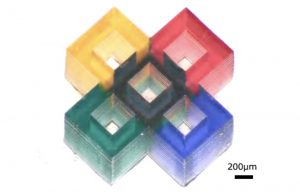
New multicolour 3D-printing technique can be used for optical devices
Canadian Plastics
3D Printing Research & DevelopmentDeveloped by researchers in Japan, the printing method can be used for developing optical, soft-robot, or medical components.

Adjusting the number of layers of multicolour resins changes the light absorbance for each part of a structure, producing layers of red, blue, green and yellow. Credit: Shoji Maruo/Yokohama National University.
Researchers in Japan have developed a new method for 3D printing multicolour and multi-material microstructures in a single-step method, which means less waste.
The technique – invented by a team from Yokohama National University (YNU) in Japan – uses stereolithography to suspend the various materials in a droplet state, which allows them to be exchanged during printing without causing voids or cross-contamination. Leveraging their novel production process, the scientists created a number of multicoloured multi-material objects, while producing less wastage, and without causing voids.
“Combining multiple kinds of materials can be used to create a function that cannot be realized with a single material,” said Shoji Maruo, team leader of the research project at YNU. “Methods like ours, that allow single-step fabrication of multi-material structures, eliminates assembling processes, allowing the production of devices with high precision and at a low-cost.”
Traditionally, incorporating more than one raw material into the 3D-printing process has been difficult – methods for swapping feedstock polymers have been investigated, but avoiding contamination between the different materials is essential.
In order to overcome these drawbacks, the Yokohama team developed a two-stage cleaning process. Firstly, the team created a glass palette that stores multiple droplets of resins and two tanks of cleaning solvent. The palette was then mounted onto a linear translational stage, where an air blowing unit in the second tank was used to dry the materials, removing any potential for cross-contamination.
In trials, the procedure was used to create a cube 1.5 millimeters on each side, fabricated from 50 layers of five different resins, requiring the resin exchange to operate successfully 250 times over six hours. The researchers also showed that adjusting the number of layers of multicolour resins could create microstructures with varying colours.
“This method can be applied not only to multicolor resins but also to a wider variety of materials,” Maruo said. “Mixing various ceramic micro- or nanoparticles with a photocurable resin can be used to 3D-print various types of glass. It could also be used with biocompatible ceramic materials to create scaffolds for regenerating bones and teeth.”
Source: Yokohama National University
